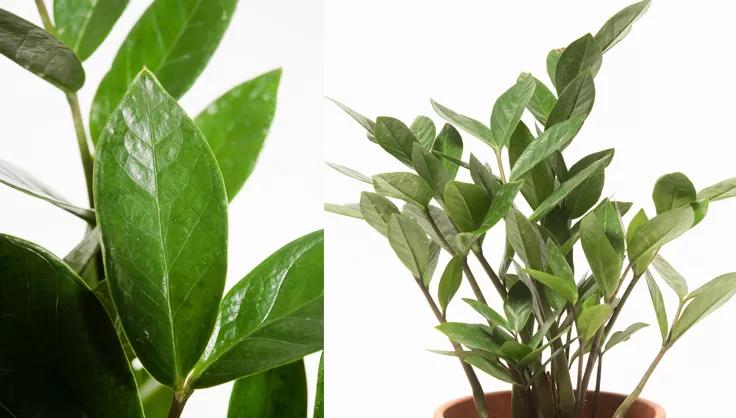How to Grow & Care For The ZZ Plant

The glossy-leaved ZZ plant is native to the dry, shady forests of eastern Africa, and therefore has many adaptations to handle both low light and drought conditions. ZZ Plants have extremely thick underground roots (rhizomes) that store water, and that waxy sheen on their leaflets is not just for aesthetics — it prevents moisture loss as well.
Brand new to houseplants? The ZZ plant is one of the easiest to care for, and an excellent starter plant. Learn more about these robust houseplants.
Cultivars of ZZ Plant To Try
Beyond the classic ZZ plant, which features bold green leaves, gardeners may want to try their hand at growing ZZ Plant ‘Raven’ which boasts dark, nearly purple-black foliage, or ZZ Plant ‘Zenzi’, a dwarf cultivar that typically grows no larger than 12 inches in height.
Best Growing Conditions for ZZ Plant
Light: ZZ plants thrive in low to medium levels of indirect light. Avoid exposing them to direct sunlight for extended periods, as it can scorch their leaves.
Soil: Well-drained, aerated soil is essential for ZZ plants. Hailing from the dry forests of Africa, ZZ plants are drought-tolerant and happy in a loose, quick-draining soil. A standard potting mix combined with perlite or sand provides prevents waterlogging.
Humidity: ZZ plants perform well in average indoor conditions without any specific humidity requirements.
How To Care for ZZ Plant
Watering
ZZ plants are drought-tolerant and prefer to dry out between waterings. Water sparingly and allow the soil to dry about halfway before watering again, typically every 2-3 weeks. Overwatering can lead to root rot.
Fertilizing
Having evolved to thrive in sandy, nutrient-poor soils, ZZ plants generally have no need for fertilizer. If you do feel the need to feed, use a balanced, water-soluble fertilizer diluted to half-strength every 2-3 months during the growing season (spring and summer).
Pruning
ZZ plants require minimal to no pruning. Remove any yellow or damaged leaves with clean scissors or pruning shears to maintain the plant's aesthetics.
Propagating
Propagating ZZ plants is possible through leaf cuttings or division. Leaf cuttings can be planted directly in moist soil, while division involves removing the plant from its pot, separating rhizomes, and potting them in individual containers.
Repotting
ZZ plants grow slowly and thus, do not need to be repotted very frequently. Check the roots — when they are twisting around each other and emerging from the soil, its time for a larger pot! As always, choose a new container with a drainage hole on the bottom.
ZZ Plant Pests and Problems
Identifying and Controlling Pests: ZZ Plants are relatively resistant to pests, but may occasionally be bothered by mealybugs, scale, and spider mites. Use insecticidal soap or neem oil to eliminate these pests.
Common Signs of Stress and Treatment
Signs of stress in ZZ Plants include yellowing leaves, root rot, or wilting.
Yellowing, mushy leaves: Overwatered plant. Adjust watering practices and ensure proper drainage to help the plant recover. Overwatering is much more common and problematic than underwatering.
Wrinkled, wilting leaves: Underwatered plant. Not very common in this drought-tolerant plant, but it can happen! Be sure to water your ZZ plant deeply so water flushes out the bottom drainage hole
Toxicity
The ZZ plant is slightly toxic and can make pets and people ill if consumed — be sure to keep out of reach of children, cats, and dogs.
ZZ Plant FAQs
Q: Can ZZ Plants tolerate low light conditions?
A: Yes, ZZ plants are excellent low-light tolerant plants, making them suitable for spaces with minimal natural light. They will grow faster in brighter conditions, however.
Q: How long do ZZ Plants live?
A: ZZ plants are slow growing and long-lived — with even the tiniest bit of care, they can live for decades!
Q: Are ZZ Plants safe for pets?
A: ZZ plants are considered toxic if ingested, so it's best to keep them out of reach of pets. Displaying them in areas inaccessible to curious animals is advisable.
Caring for a ZZ plant is a breeze! Resilient and adaptable, the ZZ plant is sure to be a winning addition to your indoor garden.
Print this Article:
Get the Dirt
Stay up to date on new articles and advice. Please fill out the information below.
